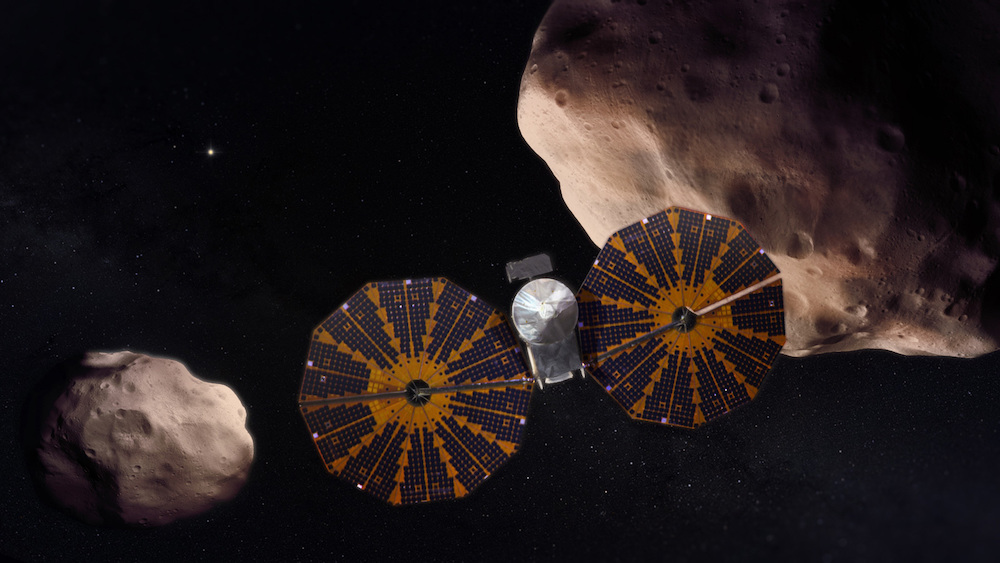On October 16, 2021, at 5:34 a.m. local time, NASA launched its Lucy mission into space aboard the United Launch Alliance Atlas V 401 rocket. from Cape Canaveral, Florida, United States. The mission, which has been under discussion since 2014, is now on its way to asteroid trojanwhich is located in the orbit of Jupiter.
Meet Lucy
Lucy, as the mission is named, will be NASA’s first mission (National Aeronautics and Space Administration – United States Space Agency) who visited the Trojan asteroid group in Jupiter’s orbit. Asteroid Trojan are remnants of the formation of the Solar System that are now trapped around Jupiter’s orbit. It should be noted that the group asteroid These do not associate or orbit Jupiter, but are scattered in the plane of Jupiter’s orbit, orbiting the Sun.
Trojan asteroids are divided into two main groups, namely the group that orbits in front of (leads) Jupiter, and the group that orbits behind (follows) Jupiter in its journey around the Sun. The number of Trojan asteroids is estimated to be approximately equal to the number of asteroids in the Asteroid Belt which is located between the orbits of Mars and Jupiter.
Why is this Trojan asteroid so interesting to scientists that they dedicated a special mission to studying it?
Various models of the formation and evolution of the Solar System indicate that the Trojan asteroids are the material remnants of the formation of the four outer planets (Jupiter, Saturn, Uranus and Neptune) that still retain their characteristics since the Solar System was formed four billion years ago. However, the surface characteristics of Trojan asteroids vary widely from asteroid to asteroid, suggesting that some of these asteroids originated in other parts of the Solar System and eventually “stranded” in the plane of Jupiter’s orbit.
Scientists hope, by studying the ancient material, they can uncover history of the solar system since the beginning of their formation, including the space environment in which the planets formed and evolved.
The purpose of this mission is the inspiration for the name of the vehicle. Lucy’s mission is named after an ancient human fossil found in Ethiopia in 1974. The night after the fossil’s discovery, archaeologists held a celebration and the song “Lucy In The Sky With Diamonds” by the famous band The Beatles played. Pamela Alderman, one of the members of the excavation team finally named the newly discovered fossil “Lucy”. This name was finally chosen by NASA as the name of the mission that will excavate the “fossils” of the Solar System to reveal its origin!
Lucy’s Scientific Mission
In order to uncover the planetary history and evolution of the surface diversity of the Trojan asteroids, the Lucy mission will make the following observations and measurements on each asteroid it visits:
- Surface geology: Lucy will map the shape, albedo (reflection/level of light reflection) and the distribution of the craters and their size-frequency. In addition, this mission will also determine the characteristics of the structure and surface crust layers as well as the relative age of the surface units.
- Surface color and composition: this activity will map the color, composition and characteristics of the surface (“soil”) and determine the distribution of minerals, ice and organic matter on the asteroid’s surface.
- Interior and overall composition: includes the determination of mass and density, as well as the study of the subsurface composition of the asteroid through a series of excavations around craters, cracks, ejecta layers and open ground.
- Satellites and rings: Lucy will search for satellites and rings on the visited asteroids.
Rides and Instruments
Overall, Lucy’s ride measures a total of 16 meters. The largest part of the vehicle is the two solar panels on the right and left sides of the vehicle body, each of which is 7 meters in diameter. The vehicle body itself, which includes instruments and communication antennas, is much smaller than the two “wings”. As can be guessed from the presence of giant solar panels, Lucy uses the power of the Sun to reach Jupiter’s orbit and carry out her mission.
Lucy is equipped with various scientific instruments to carry out her mission:
- L’LORRI (Lucy LOng Range Reconnaissance Imagerremote sensing camera): the most sensitive camera with the highest resolution. One of its main functions is to get a high level of sharpness image of the asteroid even though the asteroid itself is very dark.
- L’Ralph: this instrument consists of two main parts:
- L’Ralph Linear Etalon Imaging Spectral Array (LEISA): It is an infrared imaging instrument, which will produce spectral absorption lines. These absorption spectra are “fingerprints” of elements and chemical compounds contained in the soil, rock or ice on the asteroid’s surface.
- L’Ralph Multi-spectral Visible Imaging Camera (MVIC): is an instrument that takes images across a wide range of visible light spectrum, this camera will take color images to help determine surface composition and indication of surface activity.
- THE TES (Lucy Thermal Emission Spectrometer): this instrument is used to measure the surface temperature of asteroids by recording the thermal infrared spectrum, which is expected to help determine the physical characteristics of the material on the asteroid’s surface. This instrument is equipped with a beam splitter made of diamond. This fact makes the title of The Beatles’ song, “Lucy In The Sky With Diamonds(Lucy In The Sky With Diamonds) becomes “real”!!!
- T2CAM (Terminal Tracking Camera): is a navigation camera that will be used to determine the shape of the asteroid.
In addition to the above instruments, Lucy is equipped with High Gain Antenna. This antenna will be used to communicate with Earth, and to conduct experiments using radio technology to determine the mass of the asteroid.
Travel plans
After launching in October 2021, Lucy will make her first stage journey towards the Trojan Asteroid orbiting in front of Jupiter, or at point Lagrange 4 (L4). On this trip, Lucy will “drop in” for a flyby of the asteroid (52246) Donaldjohnson, which orbits the Sun in the Asteroid Belt. The visit was highly symbolic, as Donald Johnson, the name chosen for the asteroid, was the paleontologist who discovered Lucy’s fossil.
Although symbolic, the flyby has a function as a “dress rehearsal” before the implementation of the main mission. The Donaldjohnson asteroid is thought to be a fragment from an asteroid collision in the main belt, making it a fairly young asteroid. It is estimated that Lucy will reach Donaldjohnson on April 20, 2025.
After reaching the point of Lagrange 4, Lucy will conduct a flyby of four L4 asteroids, namely Eurybates and its satellite Queta (12 August 2027), Polymele (15 September 2027), (11351) Leucus (18 April 2028), and (21900) Orus ( 11 November 2028).
Lucy’s orbit will bring Lucy back closer to Earth for a gravitational boost, and will fly back into Jupiter’s orbit. By the time Lucy approaches Jupiter for the second time, Jupiter and the two Trojan asteroid groups have already changed positions, and this time Lucy will have reached the Lagrange 5 point, to visit the asteroid (617) Patroclus and its twin, Menoetius on March 2, 2033. Fly over the asteroid These twins are planned as the ultimate mission of Lucy.
This entire itinerary includes three gravity boosts (October 2022, December 2024 and December 2030) and visits a total of seven asteroids. When the mission ends in 2033, Lucy will be the spacecraft to visit the Solar System object with the most independent orbits.
Lucy’s Unique Facts
Space missions that have reached retirement age can be abandoned (Apollo missions), destroyed (Cassini), or allowed to sail through space (Voyager 1 and 2). After completing her mission, Lucy will remain in a stable orbit that will allow her to visit this Trojan asteroid group again and again for thousands, if not millions of years. In connection with this, scientists place a time capsule in the form of a golden plaque containing a message for the posterity of mankind who will one day find it.
Related
–


